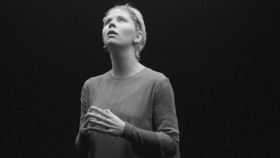


Sean McAllister: A Syrian Love Story
He is on his own, McAllister, alone with his camera, which is constantly moving to be able to catch what is going on. I have to confess that this shaky style with little aesthetic consideration irritated me in the beginning as did the director’s many words of introduction to make us (Western) viewers understand what to expect.
Having said so, there are few documentarians who like McAllister, goes from the journalistic point of view and the anynomous reportage, to be a true storyteller who captures your attention fully because of the closeness to the characters he can create, because he always involves himself – he is in this case an intruder into the lives and destinies of a refugee family that he met in 2009 and kept a close relation to until this year, 2015. His presence simply changed their lives: McAllister was caught by the regime’s people in 2011, he was put in prison for five days, and had his camera and tapes confiscated. For that reason Amer and Raghda and their four kids had to flee to Lebanon, not to be taken…
And it is in Lebanon the family starts to fall apart. Both Amer and Raghda had been in prison because of oppositional activities, they actually met there to move together to make a family in Yarmouk, the Palestinian camp near Damascus – where we meet them when Raghda is released from prison. The photo shows Amer and Bob talking to the mother – when do you come home, mother – that same Bob becomes the darling of the film and McAllister, he is the one who reacts most explicit to all the shit that happens.
For Raghda it provokes ”an empty feeling to be in Lebanon” and the move to France, where they can get political asylum because of her being on the list as a haunted political activist (or whatever way the regime phrases it) does not make that feeling disappear.
In France a conflict between the two evolves, Amer gets a girlfriend, Raghda gets more and more depressed, tries to take her own life, they shout at each other and drink too much, ”you don’t love me”, ”you never say you love me” – the atmosphere is violent, McAllister goes from one to the other, interfers, talks, discusses, tries to analyse the situation. ”I am a loser”, says Raghba.
These scenes from a marriage (yes, you can’t help think of Bergman) are terrible to watch, to say the least – you get a sense of how it must be to be away from your home, to experience the horrors going on there without being able to do anything but to open your computer and have the killings of friends documented! The kids grow up, Amer is the one taking care of them, the camera of McAllister stays very often on his face, lets the viewer try to read his face, whereas you do not have to go close to the vulnerable Raghda to see her changing moods and despair.
Happy Ending? Well, Amer stands in his garden/courtyard cutting leaves with chicken around him – the children have a future, he says, that is the most important. And Raghda, with a happy face, gets up from a chair to hug Sean somewhere in Turkey near the Syrian border, where she can again be active within the political opposition. She looks a completely different person to the one, we met in France.
Needless to say that this is an important film (completely different from the ones made by Syrians, ”Return to Homs” and ”Silvered Water”, both personal masterpieces) with a different angle: an outsider who comes to a war zone to find out what it could mean for those who live there in opposition, gets involved himself with his big heart and persistent non-sentimental compassion.
UK, 2015, 75 mins.
